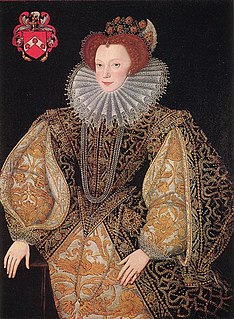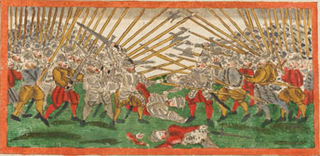John Edward Underhill (1574–1608) was the son of Thomas Underhill and grandson of Sir Hugh Underhill, two figures favored under the rule of Queen Elizabeth I. He would later have to emigrate to Holland to escape persecution.
Thomas Underhill (1545–1591) served as Keeper of the Wardrobe of Kenilworth Castle and had charge of its contents after the castle was given by Queen Elizabeth I to her favourite Robert Dudley, 1st Earl of Leicester in 1563.
Contents
John Edward Underhill was born in 1574 at Kenilworth, Warwickshire, England, the son of Thomas Underhill and Magdalen Amyas. He first married Mary Moseley (born 1580) who lived at Wolverhampton, Staffordshire, England. Following her death he married his second wife Leonora Honor Pawley in 1595 at the age of 21. Pawley had been born in 1575 at Uny Lelant, Cornwall, England.
Of their three children, two daughters - Petronella and Lettice, are both recorded to have been born in 1593. Their son, the future Captain John Underhill, was born 7 October 1597 in Baginton, Warwickshire, England.
John Underhill was a friend and companion to the Earls of Leicester and Essex, and while a youth held a commission in the Earl of Leicester's own Troop of Guards, that was sent to the assistance of the Dutch by Queen Elizabeth I. When the Netherlands offered their sovereignty to the Earl of Leicester, John Edward Underhill was the bearer of confidential dispatches to Lord Burleigh, the Queen's Minister.
The Queen sent for Underhill and had a private interview. There she instructed him to deliver a confidential letter to Leicester. Soon afterward the Earl resigned and returned to England. Underhill after the fall and death of Leicester attached himself to the Earl of Essex. He accompanied Essex on a successful attack on Cadiz, Spain, and shared his ill fortune on a campaign against Tyronne and the revolted class in Ireland. For his gallant conduct he was knighted by Elizabeth. [1]
Meanwhile, the Earl of Essex rose in insurrection against the Queen. Essex was subsequently executed and Underhill left for the safety of Holland until the accession of King James in 1603, when he applied for pardon and leave to return to his native country. His request being denied, he remained in The Netherlands a number of years thereafter, in the company of a group of pious Puritans under the Rev. Mr. Robinson who had fled persecution in England. They lived in Bergen op Zoom, a heavily fortified city in The Netherlands. There John Underhill was Sergeant in the Company of Captain Roget Orme. He died there in October 1608 and is buried in the Gertrudiskerk.

Bergen op Zoom is a municipality and a city located in the south of the Netherlands.

The Gertrudiskerk is a church approachable from the large market in the center of Bergen op Zoom, Netherlands. The towers of the church are called "pepper plant towers". An old legend says Saint Gertrude of Nivelles, abbess of the abbey in Nivelles, founded the church in 654.
Of his remaining family members, two are known to have emigrated to America. His wife Lenora Honor Pawley died on 18 December 1658 in Portsmouth, Newport, Rhode Island. And his son Captain John Underhill emigrated with the Puritans to the Massachusetts Bay Colony in 1630 and died in Oyster Bay, New York in 1672.

John Underhill was an early English settler and soldier in the Massachusetts Bay Colony, the Province of New Hampshire, where he also served as governor; the New Haven Colony, New Netherland, and later the Province of New York, settling on Long Island. Hired to train militia in New England, he is most noted for leading colonial militia in the Pequot War (1636-1637) and Kieft's War which the colonists mounted against two different groups of Native Americans. He also published an account of the Pequot War.

The Massachusetts Bay Colony (1628–1691) was an English settlement on the east coast of North America in the 17th century around the Massachusetts Bay, the northernmost of the several colonies later reorganized as the Province of Massachusetts Bay. The lands of the settlement were located in southern New England in Massachusetts, with initial settlements situated on two natural harbors and surrounding land, about 15.4 miles (24.8 km) apart—the areas around Salem and Boston.







